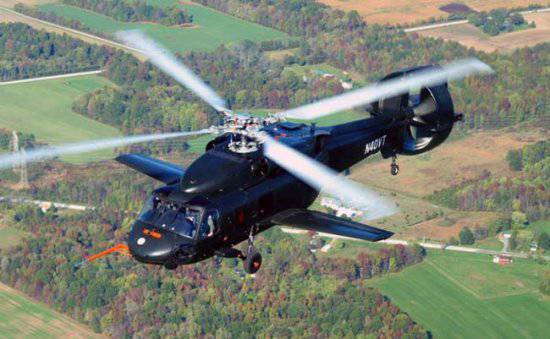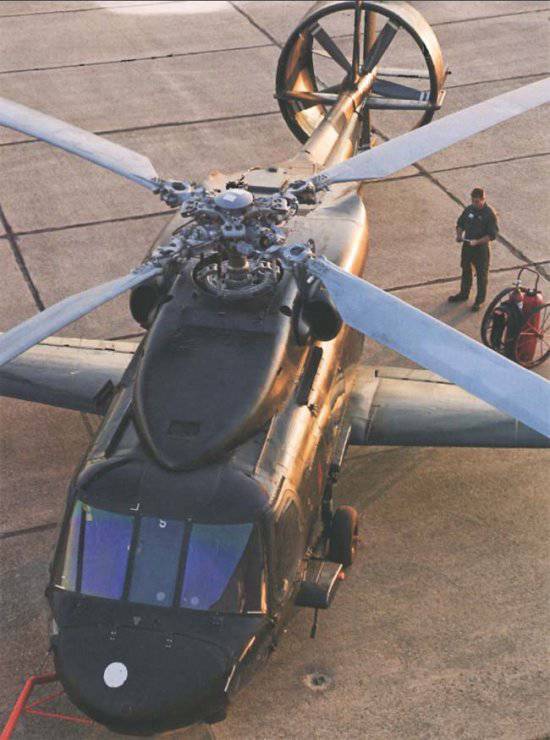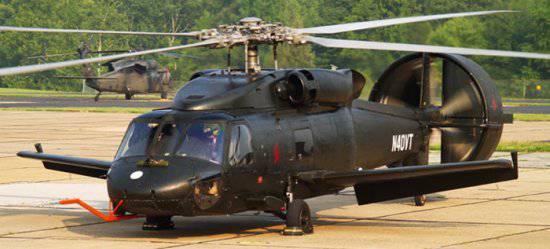Piasecki X-49A Speedhawk
Piasecki continued the theoretical work on the chosen scheme up to 1978 of the year. The return to the former topic became obvious when in the middle of 90-ies the military became interested in using Piasecki to improve the performance of AH-64 Apache and AH-1W SuperCobra. A large amount of work was carried out, including a full-scale simulation and a series of ground tests. Changes to the baseline helicopter transmissions, new control systems, etc. were required. But the result was a contract to modify the average multi-purpose UH-60 Black Hawk. Through 3, the prototype adopted the X-49A Speedhawk index. The principal difference from 16H-1 was a different design for deflecting the air flow of the pusher screw - they used a more efficient, composite hemisphere that unfolds on 90 C at low speeds and hovering, and at high speeds of horizontal flight it fits into the contour of the casing, thereby not testing loads and removing the source of vibration of the tail boom. X-49A made the 1-th flight 29 June 2007 of the year.
In 2008, the company Piasecki Aircraft received funds for the refinement and conduct of the second phase of flight tests of an experimental X-49A helicopter. It should be noted that after the completion of the first stage of flight tests, the future prospects of the X-49A SpeedHawk remained unclear. Moreover, the funding provided does not solve all the problems, because, according to representatives of Piasecki Aircraft, it is not sufficient to fully implement the program and must be increased. At the same time, the company notes positive signals from the US Department of Defense.
The first phase of the X-49A SpeedHawk flight test began in June last year. His goal was to evaluate constructive solutions that were supposed to allow the experimental helicopter to surpass the basic version of the SH-60F Seahawk in speed characteristics.
During the tests, X-49A SpeedHawk demonstrated an increase in speed of 47 percent at similar power rates with SH-60F, as well as half the level of vibrations. The technical characteristics of the helicopter were improved due to the use of a thrust vectoring screw mounted in a tube with vector thrust VTDP (Vectored Thrust Ducted Propeller) and wings, which increased the lifting force and reduced the load on the main rotor.
The nearest development plans include the installation of a third engine on the X-49A SpeedHawk, as well as retractable landing gear and fairing on the rotor hub to reduce vibration.
It is planned that the cruising speed of serial helicopters will exceed 383 kilometers per hour, and the maximum - 415 kilometers per hour, while at SH-60F the corresponding figures are equal to 241 and 256 kilometers per hour. The unloaded weight will increase by more than 700 kilograms, mainly due to the installation of the third engine. At the same time, the helicopter's payload will increase by approximately 230 kilograms, and the combat radius of action will expand almost three times.
LTH:
X-49 modification
The diameter of the rotor, m 16.36
Length, m 20.10
Height, m
Width, m
Weight, kg
empty 6900 aircraft
maximum take-off
Engine type 1 GTE General Electric T700-GE-701C
Power kW x 1 1210
Maximum speed, km / h 415
Cruising speed, km / h 383
Practical range, km
Practical ceiling, m
Crew 2



Information